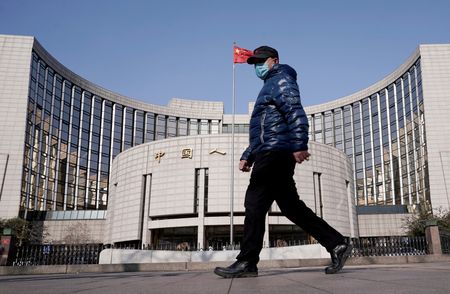By Ellen Zhang and Kevin Yao
BEIJING (Reuters) -China said on Friday it would cut the amount of cash that banks must hold as reserves for the second time this year, releasing about 500 billion yuan ($69.8 billion) in long-term liquidity to prop up a faltering economy hit by record COVID-19 cases.
The People’s Bank of China (PBOC) said it would cut the reserve requirement ratio for banks by 25 basis points (bps), effective from Dec. 5.
The central bank hopes to spur more lending into the economy but analysts are sceptical it could achieve quick results, as new COVID outbreaks throw factories and households into lockdown, with little appetite for new credit, while the outlook for already slower-than-expected growth has darkened.
“The reduction … will help banks follow through on a directive to defer loan repayments from firms struggling with widening lockdown restrictions,” Mark Williams, chief Asia economist at Capital Economics, said in a note.
“But few firms or households are willing to commit to new borrowing in this uncertain environment.”
The PBOC has been walking a tightrope on policy, seeking ways to support the slowing economy while avoiding big rate cuts that could fuel inflationary pressures and risk outflows from China, as the Federal Reserve and other central banks raise interest rates to fight inflation.
“We see limited room for further monetary easing in the medium term as the PBOC becomes more mindful of the inflation risk once China moves towards the post-pandemic era,” analysts at Citi said in a note.
On Monday, the central bank kept its benchmark lending rates unchanged for a third straight month, as a weaker yuan and persistent capital outflows limited Beijing’s ability to ease monetary conditions to support the economy.
OUTLIER COVID STANCE
The world’s second-largest economy suffered a broad slowdown in October and the recent spike in COVID cases has deepened concerns about growth in the last quarter of 2022. The economy was already under pressure from a property downturn and weakening global demand for Chinese goods.
Chinese cities have imposed lockdowns and other curbs, dampening both the economic outlook and hopes that China would soon back away from its harsh, outlier stance on COVID.
The economy grew just 3% in the first three quarters of this year, well below the annual target of around 5.5%. Full-year growth is widely expected by analysts to be just over 3%.
The central bank has cut the reserve ratio 14 times since early 2018, when it was at 14.9%, pumping more than 10 trillion yuan into the economy.
The government in recent months has also rolled out a flurry of policy measures to support growth, focusing on infrastructure spending and limited support for consumers, while loosening financing curbs to rescue the property sector.
The PBOC this week outlined 16 steps to support the property sector, while sources with direct knowledge of the matter said on Friday it will also offer cheap loans to financial firms to buy developers’ bonds, China’s strongest policy support yet for the crisis-hit sector.
Friday’s reserve ratio reduction follows a 25-bp cut in April and had been widely expected, after state media on Wednesday quoted the cabinet as saying China would use timely reserve ratio cuts, alongside other monetary policy tools, to keep liquidity reasonably ample.
The cut will lower the weighted average ratio for financial institutions to 7.8% and will affect all banks except those implementing a 5% reserve ratio, while lowering banks’ annual funding costs by about 5.6 billion yuan, the central bank said.
“[It will] keep liquidity reasonably sufficient and promote a steady fall in comprehensive financing costs,” while helping to stabilise the slowing economy, it said.
The PBOC also said on Friday that it would step up the implementation of its prudent monetary policy and focus on supporting the real economy, while avoiding flood-like stimulus.
($1 = 7.1640 Chinese yuan renminbi)
(Reporting by Beijing newsroom, Ellen Zhang and Kevin Yao; Editing by Edmund Klamann)

